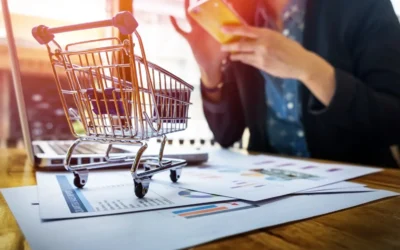2019 Called and It’s Not Coming Back. Now What?
The COVID-19 crisis has created an imperative for companies to reconfigure their operations—and an opportunity to transform them.
Retail and Direct-to-Consumer has Changed. Forever
We have all seen it as a business or as a customer. Online adoption for essentials like groceries, home office equipment, and more has skyrocketed this past year and will not drop back to pre-pandemic levels. For this reason, more retailers should think about how to better cater to older consumers, who in 2020 became much more comfortable shopping online during the pandemic. That includes purchasing essentials from industries like groceries, pets and agriculture, and pharmacy.
Necessity is the Mother of All Invention
2021 will be a year when companies double down on technology, especially for B2B Brands, Retailers, and Manufacturers in terms of eCommerce platforms, digital storefronts, and improving their supply chains. Many executives in a McKinsey survey reported that they moved 20 to 25 times faster than they thought possible on things like building supply-chain redundancies, improving data security, and increasing the use of advanced technologies in operations. With the coronavirus overburdening fulfillment centers and workers, more retailers will adopt automation such as robotics and artificial intelligence technology to increase efficiency and productivity. In fact, it’s worth noting that according to the US Bureau of Labor Statistics, US productivity in the third quarter of 2020 rose 4.6 percent, following a 10.6 percent increase in the second quarter, which is the largest six-month improvement since 1965!
Cost differences among developed and many developing countries are narrowing. In manufacturing, companies that adopt Industry 4.0 principles (meaning the application of data, analytics, human-machine interaction, advanced robotics, and 3-D printing) can offset half of the labor-cost differential between China and the United States. With the development of AI and data analytics, companies can and should learn more about, audit, and connect with their entire value chains.
eCommerce will become harder in 2021 than it was in 2020. As usual, the advantage will go to the agile, adaptable, and innovative retailers. Increasingly, that includes having a conscience.
After being burned by the pandemic, businesses will seriously invest in diversifying their fulfillment options, having multiple backup options for sourcing products. The same goes for curbside, delivery, pick up, and 1P and 3P warehousing. In fact, we expect app-based delivery services like Instacart, Mercato Inc., DoorDash, and similar, to gain more clients in 2021 as small chains and independents try to keep up. Domestic product sourcing will become a larger priority for retailers as they continue to evaluate the logistics of overseas production. In other words, they should invest more and think long and hard about contingency plans for these areas of their businesses.
Some SMBs will invest more in social media and messaging apps as a separate eCommerce channel. eCommerce will become harder in 2021 than it was in 2020. As usual, the advantage will go to the agile, adaptable, and innovative retailers. Increasingly, that includes having a conscience.
A number of clients have highlighted their environmental and sustainable priorities on their website as differentiating features for their businesses. More businesses will do this with both the environment and other values, such as diversity or made-in-America products.
For brick and mortar to thrive, merging the digital and physical, using customer data to drive outcomes, and allow for agile innovation, must be the norm in 2021.
The Death of Brick and Mortar Has Been Greatly Exaggerated
Sometime in the coming year, if the vaccine rolls out as anticipated and most of the population has access to it, there will be a turn of the tide against eCommerce. People will long for the social, emotional, and physical connection of shopping in a store and there will be a big uptick in store-based shopping.
What brick and mortar look like in 2021 will be WAY different than in 2019. Think of locations being more like fulfillment centers, experience centers, and models of efficient operations. This is critical for the physical location to survive.
Look Beyond Amazon
Selling on third-party marketplaces will dramatically shift over the course of 2021. A lot of entrepreneurs have made a good living on Amazon up until now, but that won’t be so easy in 2021 and beyond, especially for the highly competitive CPG space. A new type of company has emerged in recent years that raise lots of capital and then buys small Amazon brands, with the idea of putting more resources behind those brands and increasing sales and profits. The more these Amazon aggregators grow, the more difficult it will be for smaller brands to sell on Amazon.
But, How Do We Really Know What 2021 Holds For Us? Look East (and Down Under)
According to McKinsey and the Financial Times, we can predict 2021 with some confidence. China provides us with a great case study precursor to how things might shape up this year for the US and Canada. The first country to be hit by the COVID-19 pandemic, it was also the first to emerge from it. China’s consumers are relieved—and spending accordingly. On Singles Day, November 11, the country’s two largest online retailers racked up record sales. That wasn’t just a holiday phenomenon. While manufacturing in China came back first, by September, so had consumer spending. Except for international air travel, Chinese consumers have begun to act and spend largely as they did in pre-crisis times. Australia also offers hope. With the pandemic largely contained in that country, household spending fueled a faster-than-expected 3.3 percent growth rate in the third quarter of 2020, and spending on goods and services rose 7.9 percent.
What Do We Do First? Priorities for 2021
This year, brands will need to evolve into platform companies by building a value-enhancing ecosystem of products and services to strengthen customer loyalty.
This year, brands will need to evolve into platform companies by building a value-enhancing ecosystem of products and services to strengthen customer loyalty. They will be powered by a self-learning digital ecosystem and algorithmic supply chains while leveraging data and insights to drive decisions. To excel in 2021, the following steps must become a top priority and within a short period of time (think 90 days and not 9 months):
- Rationalize Your Capital For A Digital Norm – For retail, it may mean “dark stores” that serve as fulfillment centers. For manufacturing and distribution, it may mean providing automation and thinking of alternatives for fulfillment. The profitability of online channels will be critical, and you will have to drive a sustained improvement of financials in these channels.
- Prioritize Through Data – Brands will need to break down data silos across the enterprise to allow for business leaders to make data-driven decisions that enhance business performance. The top impacted areas will include marketing, merchandising, and supply chain operations.
- Modernize Your Digital Infrastructure – Integrating commerce (systems touching customers, products, and orders) through more sophisticated data (think Machine Learning or AI) that constantly optimize and curate experiences.
- Organize Talent To Be Digitally Enabled – Even if you outsource your development, marketing, and other digital commerce efforts, having even one liaison for each is critical to ensure you are maximizing your investments and getting your return on investment. Furthermore, new customer demands to be more digital require more learning and development to arm your teams with the tools to manage them.
- Rethink/Redo Your Long Term Strategy – If you did not do this in 2020, you must consider the impacts the pandemic has had on your business and re-shift focus on a roadmap that works for growth in the new world.
Conclusion
2021 will reveal the clear long-term winners that can compete in a post-pandemic world. These winners will have one thing in common — they have all used lessons from 2020 as an opportunity to transform themselves rapidly, leveraging digital as a key enabler in the service of their customers.
As always, BlueSky Commerce can be your partner – using our insights from our clients and our 360 Approach to your business.





